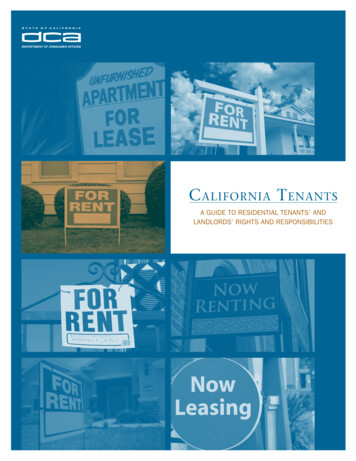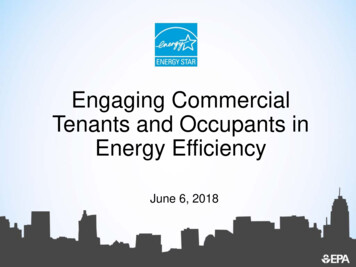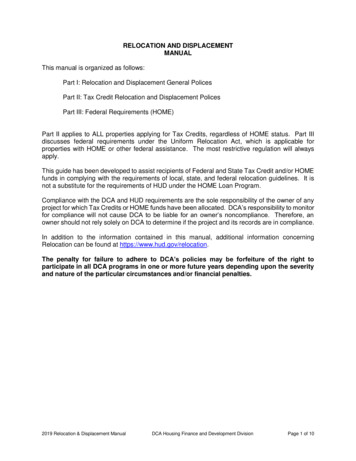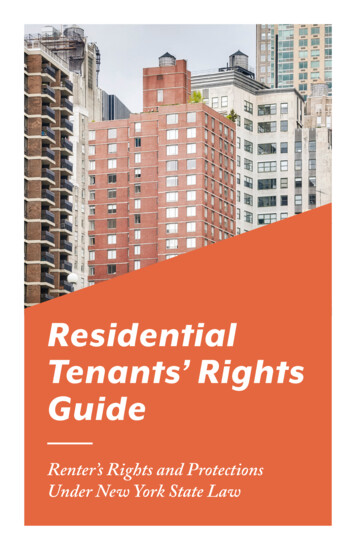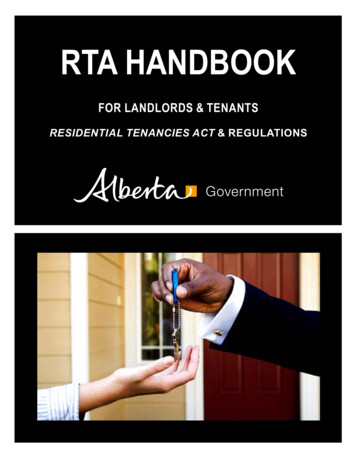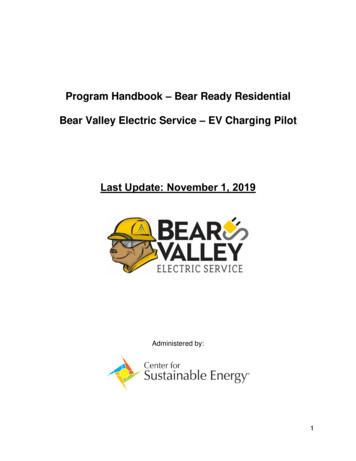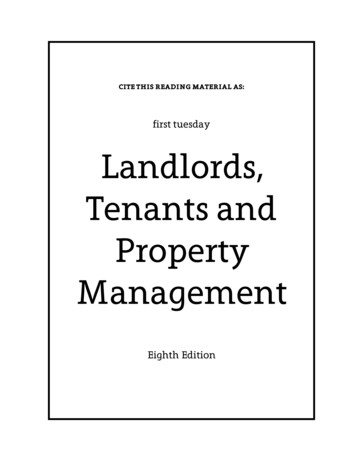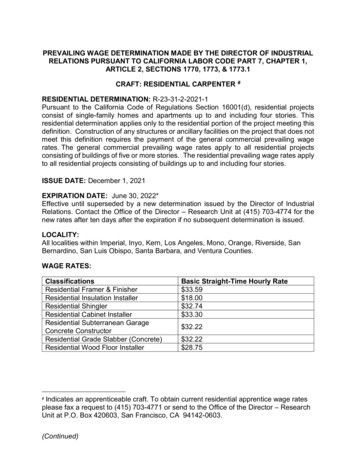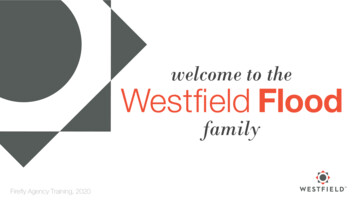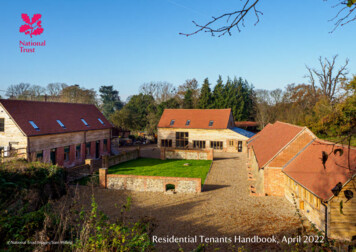
Transcription
National Trust Images/Sam MillingResidential Tenants Handbook, April 2022
Residential Tenants HandbookYour guide, to your TenancyWelcomeThe National Trust as a landlordPersonal Data, Fees, Charges and DepositsSettling iinWho does what? (Landlord)Who does what? (Tenant))Home improvementsLooking after the propertyKeeping your home safeSafety! Carbon MonoxideMaintenance, Servicing and RepairsLiving in a National Trust propertyGetting involvedLife in the CountrysidePets and GardensLiving sustainablyBeing a good neighbourTenant Pass(Custodian Membership)Tenancy Details – EnglandTenancy Details – Northern IrelandTenancy Details – ing rentReviewing rent levelsUnderstanding the terms of your tenancyMoving onnHow to give feedback or make a complaintGetting in touch with us303132333434To navigate this document, you can scroll through each page,using the forward and back arrows or click the adjacent pageheadings to jump straight to that section. The contents icon atthe bottom of each page returns you to this index. 1
Welcome!The keys in your hand are about to open a new chapter in your life.Whether you are moving into a cottage or to the wing of one ofour mansion properties, once you step over the threshold, you willbecome an integral part of the National Trust and the building’sstory. Whatever your reasons for choosing to be a National Trusttenant, we hope that you will enjoy making the property yourhome, a home which we hope you will be happy in for many yearsto come. This handbook is intended to give you all the informationand support you need to make the property your home and buildwhat we hope will be a happy and long-lasting relationship with theNational Trust.As the National Trust’s Director of Land and Estates, it is myresponsibility to oversee our rental houses and cottages and toensure not only that all of our tenants are receiving a good level ofservice but also that our buildings are protected, as an integral partof our historic built environment, for generations to come. In thesepages you will find all the essential information we think you willneed to enable you to settle into your new home. In particular, youwill find details of who to call for repairs or advice along with somehints and tips to help you make the most of your new home.Welcome to the National Trust and I very much hope you enjoyyour new home.Giles Hunt, Land & Estates Director National Trust Images/Sam MillingContents 2
National Trust as a landlordYour property is one of around 5,000 houses and cottages weown and rent out. Many of these places are on larger estatesthat we have acquired and sometimes they include entirevillages that were once homes for estate workers. The housesthat we let out on residential tenancies form a significantpercentage of the number of buildings that we own and carefor. The Trust is a conservation Charity, the income from thehomes we let out plays an essential part in funding both themaintenance of these properties and our many special places,to which we provide access to tens of millions of people eachyear. Our status as a Charity means we are bound by theCharities Act to rent out properties on the best terms we canreasonably obtain.For everyone, for everThe National Trust is committed to promoting and preservingthose places of natural beauty and historic interest for which ithas the privilege to be responsible for the benefit of the nation.Our strategy 'For everyone, for ever', outlines how we willachieve this, click the picture below to read the full document;-As landlords we aim, above all, to be fair and professional.We recognise we have an important responsibility to youand to all our residential tenants. We want to provide youwith as good a service as we can. Our priorities are to: provide warm, comfortable homes maintain all of the houses and cottages we own as part of ourhistoric environmentIn it for the long termWe know that one of the things that is most important to ourtenants is the knowledge that unless there are unexpectedcircumstances or disputes, they can enjoy their tenancy of aNational Trust property for the long term. There are timeswhen our plans for a rental property may change, but in themajority of cases, we are keen to build long-lasting tenantlandlord relationships.Our 21st-century ambition is to play a major role in the fight againstclimate change, meet the needs of an environment under pressure,and the challenges and expectations of a fast-moving world.Underpinning this is our renewed commitment to diversity andinclusion and playing our part to create a fair, equal society, freefrom discrimination. raise income for our core purpose workContents 3
National Trust Images/Charlotte ElliottContents 4
Your Personal DataFees, Charges and DepositsThe security of your data is important to us. You can find ourPrivacy Policy at;-The Tenant Fees Act 2019 and Renting Homes (Fees etc.) (Wales)Act 2019 legislation restricts a Landlords ability to charge feesassociated with residential lettings.We will need to collect and process some of your personal dataat various stages of your tenancy from the initial viewing,through to processing your tenancy application, creditchecking, referencing and ongoing communications with you.As a Tenant of the National Trust, we will use your personalinformation to fulfil our contract with you. This may include, butis not limited to, sending you rental invoices, tenant andlandlord correspondence, or contacting you with informationabout issues or activities relating to your tenancy or property.We will not pass your details to third parties except where youhave provided explicit consent, or where we need to do so inorder to fulfil our legal or landlord responsibilities. For example,sending your address or contact details to a maintenancecontractor so they can carry out repairs, or where we are requiredto liaise with Council Tax departments or Utilities companies atthe beginning or end of your Tenancy.Our Let Estate Teams will manage this process with youthroughout your tenancy and will manage the deletion orretention of documents as per our Retention Schedule.A copy of our Permitted Fees Schedule will be provided to youwhen you apply for a Tenancy, detailing any costs associated withthe property letting. We do not take or hold residential lettingdeposits for our residential tenancies in England or Wales.Right to Rent Legislation (England)The UK Government requires landlord s in England to completeRight to Rent checks on each adult, over the age of 18 , applying tolive within the property. You can find further details How to Rent Guide (England)We will provide you with a copy of the UK Governments "How toRent Guide". It provides a checklist and more detailed informationon each stage of the letting rent ntents 5
National Trust Images/Charlotte ElliottContents 6
Settling in Contact all the relevant utilities suppliers to the house – gas,electricity, water and telephone/broadband Consider home contents insurance Transfer your TV licence to your new address Let your local council know you have moved so that they canupdate their records for Council Tax and any housingbenefit you might receive Change your personal address details (bank accounts forexample) and arrange a postal redirect service.The inventoryYou will be given a ‘schedule of condition’ or an inventory tocheck through. This document describes the condition of yourhome at the start of the tenancy and lists the items, fixtures andfittings included in the tenancy. It’s an important documentbecause it records what we have jointly agreed to be thecondition and contents of the property when you moved in. Itwill be used to determine whether or not you are leaving theproperty in the same condition when you move out.Who can live with you.?Any members of your immediate family (Partner and children) can livewith you, although if you want other people to move in, you will needto get our consent. Please note that anyone over the age of 18 wholives in the property, whether they are a close family member or not,will need to be named on the tenancy.Household break-upsUnder current UK law, if you are married or in a civil partnership andyour relationship ends, both of you have the right to stay in theproperty while you are still married or civil partners. You should takelegal advice on your ability to remain in the property as it will dependon your specific circumstances. Speak to us at an early stage so wecan work with you. If you are not married your rights will depend onwhether the tenancy is held in one name or in both names. Moving in. .top tips for TenantsContents 7
National Trust Images/Charlotte ElliottContents 8
Who does what ?Landlord’s responsibilitiesOur aimsOur aim is to be a fair and responsible landlord, providing goodhomes for responsible tenants. We also want to do everything wecan to build sound relationships with our tenants and thismeans being clear about our respective responsibilities andcommunicating well. The details of each individual tenancyagreement may vary, but all tenancies are based on commonprinciples, explained over the next few pages. Please alwaysrefer to your own individual tenancy agreement for thespecific terms attached to your rental property.Our customer service standards Make sure any National Trust employee or contractor whovisits can show ID Investigate any complaint you make to us Continually review and monitor our services, to makeimprovements where we can.Our rights and responsibilities as a LandlordAs the property owner and landlord, the National Trust hasthe right to: Enter the property so we can carry out repairs, inspectionsand general servicingAs landlords, we aim to: Treat all our tenants with dignity and respect. We’ll also treatpeople equally and fairly, making sure no tenant is treated lessfavourably than another, for example on grounds of race, ethnicorigin, religion, gender, sexual orientation, age or disability Review and change your rent and add any other relevantcharges, such as service charges or recharges (some propertiesare supplied by community heating systems, for example) inaccordance with your tenancy agreement. Communicate in a way that’s professional and courteous. We’llcall back promptly if we’re not available when you want to get intouch Respect the fact that the property is your home, leaving youto enjoy it without unnecessary interruption or disturbance,and consulting you if ever there are changes proposed to thetenancy agreement. Complete the repairs for which we’re responsible (see page 16for details), as efficiently as we can. Where possible, arrange any meetings to take place at the rentedproperty. We’ll make sure we keep any appointments we make. Ifwe’re late or can’t get there, we’ll explain whyIn return, it’s our responsibility to:Contents 9
Depending on the type and duration of your Tenancyagreement, we will normally look after the main structure ofthe building. In most cases, this includes maintaining:– the structure and exterior of the building and outbuildingswe are responsible for, including roofs, chimneys and walls,and any access paths and steps– the outside decoration including, doors and window frames(not the glass, see page 13) and the condition of internalplasterwork (not including minor cracks)– drains, septic tank equipment, gutter repairs and externalpipes– gas piping, electrical wiring and all their fittings, and theheating and plumbing installations and appliances we haveprovidedWho does what ?Tenant’s rights and responsibilitiesYour rights as a tenant You have the right to live peacefully in your home. You should notexperience any unnecessary interruption from the Trust or anyoneworking on behalf of the Trust. You cannot terminate your tenancy agreement within the initial fixedperiod unless there is a break clause, but if you wish to do so after thefixed term has passed you can serve one month’s notice in writing to yourResidential Lettings Contact (see page 33 for more details about what todo when you decide to move on).– the water systems within the property, carrying out anymeasures required to control legionella (specifically when thereis a change of tenant)– before the start of any tenancy, we will normally conduct asurvey of any material we know contains asbestos. If we knowthat there is asbestos in your property, we will advise youabout its nature and location so you will know to avoid anyactions that may cause disturbance or damage and how toreport any incidents. National Trust Images/Sam MillingContents 10
Your responsibilitiesIn return, we ask that you: Look after the property, as set out in the terms of your tenancyagreement, clearing gutters and rainwater goods regularly Pay your rent on time, on the dates set out in your agreement orany other dates we have agreed Live in your home and do not sub-let any part of it Avoid being a nuisance or annoyance to your neighbours or others Do not use the property for trade or commercial activities Manage your households waste and recycling, tidily and securelyto prevent damage and infestation by pests or vermin Give our staff access to your property to check its condition,complete repair or maintenance work, or discuss any relevantmatters with you Communicate with the National Trust team in a way that’scourteous and co-operative. For instance, if you can’t keep anappointment, let us know; and make sure no-one in your householdever treats our staff or contractors in a way that’s abusive, threateningor perceived as harassment Let us know in writing if you plan to leave, giving us at least one month’snotice following the end of your fixed term Make sure the property is in good condition when you leave, redecoratingthe property in approved colours at the end of the tenancy if necessary Notify us of any repairs required as soon as they arise. National Trust Images/Sam MillingContents 11
Home ImprovementsAs a rule of thumb. for Assured Shorthold TenanciesOur view is that a lived-in house is a cared for house, so wehugely value the role our tenants play in the ongoingconservation of a building and we strive to build goodrelationships. We have also been working hard on this, puttingcentral investment into improving the quality of our properties.Our tenants have high expectations of their National Trust rentalproperty – the accommodation, the location and the community.In return, we expect tenants to look after the property right to theend of the tenancy.We have also listened and we are making continualimprovements. We have implemented a new, single andnationally consistent 24-hour Tenant Repair hotline.See page 18 for details.Firstly, always check your tenancy agreement and whether theproperty is Listed , to identify whether you may needpermission from NT or the Local Planning Authority. Decorating the inside is generally fine, in most cases it isyour responsibility. When you move, you will need to return itto the same condition as when you first arrived. So that mightmean if you have used strong dark colours on the walls youmay have to repaint them the colour they were when youmoved in In many of our historic properties you will need to usespecialist breathable paints, please ask if you are not sure! If you want to hang pictures or make any fixings, it is bestto check with your local Residential Lettings Contact first. Insome properties, our formal consent may be required to avoiddamaging fragile walls or breaching planning legislation Decorating outside is our responsibility. Your tenancy cangive you more information. In the garden, please do bringcolour to flower borders and plant pots or sow vegetable beds. National Trust Images/James DobsonMaking the property your own: what’s OK, what’s notContents 12
Looking after the propertyAs tenants, we ask you to: Look after your own belongings and keys to the propertyUnless agreed with us in writing, please do not alter or change: Arrange sufficient Home Insurance to cover your own contents The appearance or structure of the property in any way Keep the property clean and in good condition. In particular, weexpect you to keep the interior decoration of the property in goodcondition; keep the windows clean, inside and out; keep sinks,baths and showers unblocked; make sure you regularly clean andde-scale any showerheads Gas, electrical or plumbing installations External aerials or satellite dishes Trees, hedges, garden walls, sheds or greenhouses. Replace glass panes; bath and basin plugs and toilet seats; fusesand light bulbs Manage your domestic waste and recycling to discourage vermin Keep the garden neat, tidy and well maintained. This includestrimming hedges at least once a year, not cutting down any trees,or making significant changes to the garden without our writtenconsent. Your boundary of the property must not change.Please let us know if: We need to do any repairs (see page 18) There are any water leaks within the property You have any queries or concerns regarding trees on the property. National Trust Images/Sam Milling The hot water/heating system is not heating up properly or ifthere are any other problems with the systemContents 13
National Trust Images/Lucy CurtissContents 14
Keeping your home safeCompliance Tasks and Safety ManagementIt’s essential that your property is safe for you to live in. Wehave a dedicated central team managing the compliance checksand activities required across our let residential estate.Throughout your tenancy, we will arrange a series of checksand servicing on a range of items within the property.Depending on the different types of heating, drainage or watertreatment equipment installed at your home, this will include: Gas Safety checks Oil Boiler Servicing EICR Inspection (Electrical fixed wiring) Solid Fuel Burner Service Chimneys/Flue Inspection Heat Pump Servicing Septic Tank Maintenance Private Water SupplyIf you have any queries or concerns relating to any repairs ormaintenance at your home, please contact our Repairs andMaintenance Response Line service (see page 18). National Trust Images/David LevensonContents 15
Safety! Carbon monoxideTake action to prevent carbon monoxide poisoningWe may have installed Carbon Monoxide detectors in theproperty in rooms with solid fuel appliances.If you suspect there is a leak at your property, you MUSTimmediately:Carbon monoxide poisoning can cause headaches, collapse,breathlessness, stomach pains, nausea/ drowsiness, erraticbehaviour, dizziness, visual problems, loss of consciousness, chestpains, tiredness and vomiting. Unlike gas, carbon monoxide doesnot smell and so leaks are hard to detect. Turn off the appliance if it is automatically fed with fuel,for example, gas or oil Open all doors and windows. Go outside and don’t goback in until you know the heating system is fullyextinguished and any gases have dispersed If you feel unwell, depending on the urgency, call 999 foran ambulance, go to your doctor or call NHS Direct,explaining your symptoms may be caused by carbonmonoxide poisoning Notify us of the fault as soon as possible via our TenantRepairs service (see page 18) Do not use the appliance again until the appliance and thechimney have been inspected by a competent registeredinstaller or chimney sweep, and they have confirmed it issafe. National Trust Images/Steven BarberContents 16
Keeping chimneys and flues cleanIt is the tenant’s responsibility to organise and pay for anysweeping or cleaning. The National Trust will also organise for achimney/flue inspection once a year.Please take the following precautions when it comes to open firesand solid fuel appliances: Check any chimney or flue has been approved by the Trust assafe before you begin using it Make sure you are using the fire/system safely, having read andunderstood any relevant instructions, and made sure there isthe right level of ventilation Keep the chimney or flue clean and swept at the rightfrequency (see details below).Does your chimney need sweeping more than once a year?Don’t assume that it’s ok for a chimney to be swept just once a year– the recommended frequency depends on what’s being burned andhow regularly you’re burning it.Smokeless fuel or Oil - Once per yearCoal or Wood - Quarterly when in useUse a qualified chimney sweep National Trust Images/Arnhel de Serra If you need to use a contractor to clean your chimney or flue, pleasemake sure they have the right credentials – either HETAS approved,or a member of one of the following bodies: The National Associationof Chimney Sweeps (NACS), The Guild of Master Chimney Sweeps orThe Association of Professional and Independent Chimney Sweeps(APICS).Contents 17
Maintenance, Servicing and RepairsHow long does it take to get repairs done?We carry out most of our repairs as part of a plannedmaintenance cycle, for example, exterior decorations. Whilewe’re completing these, we’ll often check to see if there is anyother maintenance we can take care of at the same time.We will contact you to discuss your repair within 5 workingdays of reporting to the Tenant Repairs line, unless it is anemergency in which case we will respond the same day.We will let you know when we plan to undertake any routinemaintenance and repair work, which we aim to complete to agood standard and with minimal disruption.Repairs and Maintenance Response LineIf you occupy a property which is within or very close to a National Trustmansion or visitor business, you will already have been notified of your ownspecific arrangements and local contact for repairs. If this applies to you,please use these local contacts, as an alternative to the details below.If you need to contact us for repairs or in emergencies, you can useany of the following ways to contact us;24/7 Locally Charged Telephone Line: 0345 646 1311We will either allocate the job to an emergency contractor ora member of our building team. We will agree with you thelevel of urgency and timescale in which we will complete thework. We generally categorise repairs on our list as either:Emergency: This includes issues that are a risk to anoccupant’s health, safety or security, or may have a seriousadverse impact on the buildingUrgent: This includes problems that cause an occupantserious discomfort, inconvenience or nuisanceRoutine: This includes issues that aren’t causing seriousdiscomfort, inconvenience or nuisance to anyone, or causingany risk to the building itself. It may be that the repairs canwait until the planned maintenance work is due, if thistimeframe is reasonable.Online Tenant Portal: NationalTrust.fixflo.comEmail: tenantrepairs@nationaltrust.org.ukThese services are available for reporting repairs 24 hours a day.However, outside the hours of 9am to 5pm, Monday to Friday thetelephone line is for urgent matters only.This telephone service is operated by a dedicated team of trainedstaff who have direct contact with our contractors.If you are a Welsh speaker, our bilingual service is also available onthe same number between the hours of 7am and 8pm.Contents 18
If repair work is not carried out as agreedWe will always try to do repairs by the deadlines we’veagreed with you. If this isn’t possible, we will let you know,explain the reasons and agree revised timings.If we haven’t done the work and haven’t let you know,please get in touch with your local contact (see back page sowe can look into the issue and rearrange the work as soonas possible. If you have a problem that cannot be sorted outby the local contact, you can make an official complaint (seepage 33) We are always glad to have feedback on yourexperience with contractors and their service.Our aim is to complete all repairs promptly. In many caseswe achieve this, but there are times when repairs ormaintenance can take a while to get started or complete.Our entire estate consists of around 25,000 buildings andmany of our commitments are to repair sensitive orhistoric buildings that require specialist care and attention.One reason is that the right experts, artisan-levelStonemasons or Thatchers for example, aren’t alwaysavailable whenever we need them. If we expect a delay inany planned work, we will always tell you. In return, werespectfully ask for your kind understanding and patience. National Trust Images/Rebecca LarterContents 19
Living in a National Trust propertyGetting to know the history of your home‘Vernacular architecture’ is the term used to describe buildingsthat reflect local historic styles and traditions, using localconstruction materials. Some vernacular buildings give usimportant insights into what life was like when they wereconstructed.We have conducted detailed surveys of the most significant ofthese properties. If your property is one of them and you areinterested in learning more about its history and significance,we are happy to share its Vernacular Building Survey. YourResidential Lettings Contact can give you the details. National Trust Images/Sam MillingCondensation- Utilise the heating as needed to maintain a background heatof at least 18 degrees throughout winter- Make full use of extractor fans in bathrooms and kitchens- Avoid drying washing indoors, or on radiators- Open windows to provide ventilation- Utilise breathable paints to help walls expel moisture- Report any problems via our repairs service, see page 18.Going away for a week or two.?If you are intending on leaving the property empty for more than acouple of days, or for longer periods when you are on holiday, thereare some important actions that you can take to prevent damage to theproperty. These include:- Leaving the heating on a low timer setting to prevent frost damageto the boiler, pipework or water supply in winter- Turn off the mains water supply stopcock- Ensure to lock the property and any outbuildings or sheds. When living in a historic property, it is important tounderstand and manage condensation. Your ResidentialLettings Contact will provide you with guidance on yourspecific home. The following measures are all good generalpractice and will minimise condensation and the associatedpresence of black mould in houses:Contents 20
Getting involved.If you want to get more involved with other tenants and yourlocal National Trust community, speak to your ResidentialLettings Contact and they will point you in the direction of thenearest tenants’ association group. We welcome and encouragethese groups as a way of dealing with any issues locally andindependently.Here are some of ways you can get involved if you are interested: Sharing information about the property you live in. Sometimestenants build up an intimate knowledge of the property’s historyand we’re always keen to learn from this and add to our vernacularbuilding records. Likewise, we can share what we know aboutthe legacy of your place if you are interested. Keeping up to date with what’s on through local or nationalTrust newsletters and the tenants’ space on our main websitehomepage for our residential and farm rm-lettings For those of you who want to get more deeply involved, take alook at the Volunteering pages on our website for detailswww.nationaltrust.org.uk/volunteer And finally, don’t forget to make the most of your NationalTrust Tenant Pass by visiting other Trust properties in yourarea (see page 26). National Trust Images/James DobsonContents 21
Life in the CountrysideThe Countryside CodeMost of the properties we own are in rural locations and many ofthem are linked to agricultural activities, woodlands or commonland. The updated Countryside Code sets out guidelines to helpyou respect, protect and enjoy the countryside.Your pets, for example, must be under control at all times andmust not worry livestock or disturb wildlife. When you are outwalking, it is important you stick to paths on public rights ofway. You should always check whether land such as moorland,woodland or at the coast has open unrestricted access, forexample on an OS Map or online at:www.magic.defra.gov.uk/MagicMap.aspxNot all National Trust land is open access, much of ourcountryside property is let to our agricultural tenants, we askyou to respect the land, livestock and wildlife that may be part ofyour neighbour’s or community’s livelihood.You can read the updated Countryside Code by going ide-code National Trust Images/Andrew ButlerContents 22
Pets and gardensKeeping petsIf pets are part of your family we would like to welcome themtoo, but we do need to make sure the type and number ofpets are appropriate for the property you live in and will notdamage it or disturb your neighbours. If you would like tokeep pets, please discuss this with your local ResidentialLettings Contact to request permission.We will normally give our consent, especially for cats anddogs, as long as you agree to deep clean all carpets justbefore you move out when your tenancy ends. Please donot install any cat flaps into doors, erect hutches, cages orpens without our prior consent. If the animals become anuisance or damage the property, we reserve the right towithdraw our consent for you to keep them there. National Trust Images/Caroline ArberContents 23
How does your garden grow?For all Assured Shorthold Tenancies, unless stated otherwise inyour agreement, we will carry out essential maintenance to wallsand fences that we own around your boundaries and maintainthe main path and/or driveway leading to your property. Youare responsible for keeping your garden tidy and clear of anyrubbish as well as making sure you maintain any hedges, so theydo not overhang
story. Whatever your reasons for choosing to be a National Trust tenant, we hope that you will enjoy making the property your home, a home which we hope you will be happy in for many years to come. This handbook is intended to give you all the information and support you need to make the property your home and build
